|
Related FAQs: Marine Life
of the Tropical West Atlantic, Tropical West Atlantic 2,
Related Articles: TWA
Invertebrates, Algae, Vascular Plants, Introduction to Fishwatcher's Guide
Series Pieces/Sections, Lachnolaimus maxiumus/Hogfish, Hogfishes of the Genus
Bodianus,
The Tropical West Atlantic:
Bahamas to Brazil, Part 9
To: Part 1, Part 2, Part 3,
Part 4, Part
5, Part 6, Part 7, Part 8,
Part 10, Part
11,
|
|
| Bob Fenner |
|
Combtooth Blennies, Family Blenniidae, Scaled Blennies, Family
Labrisomidae, Flag Blennies, Chaenopsidae, Triplefins, Family
Tripterygidae, Suborder Blennioidea. Like most tropical and cool
water marine environments on this planet the TWA is blessed with a
plethora of blennioid species. With the continuing growth of the reef
part of our hobby, you can expect more from this area as time goes by.
Presently the less-desirable, Redlip (Ophioblennius atlanticus) (1) and
Seaweed Blennies (Parablennius marmoreus) (1) make up the bulk of the
Atlantic Blenny market. These species are okay in looks, but leave much
to be desired in their pugnacious territorial behavior.
Ecotype: Shallow rocky reefs.
| Ophioblennius atlanticus
(Valenciennes 1836), the Atlantic Combtooth Blenny. Tropical
Eastern and Western Atlantic. To more than seven inches in the
wild. Aquarium images. |
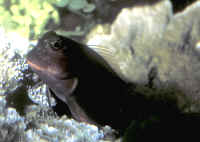 
|
| Acanthemblemaria aspera Metzelaar 1919, the
Roughhead Blenny. Tropical West Atlantic. To 1 1/4" long.
Conspicuous cirri above eyes. Color variable. Here in a hole
in Cozumel. |
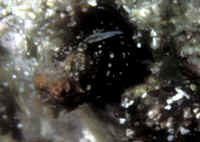
|
| Malacoctenus bohlkei Springer 1959, the
Diamond Blenny. Tropical West Atlantic; Bahamas to Belize. This one
off of South Bimini. To about two and a half inches in length.
Easily approached underwater, once observed! |
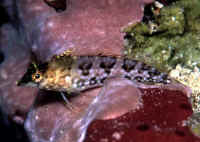
|
|
Malacoctenus triangulatus Springer 1959, the
Saddled Blenny. Western Atlantic; Bahamas to Brazil, St.
Paul's Rocks. To three inches in length. This one happily
perched on a leather yellow coral (Hi Don!) in captivity.
|
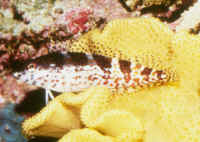
|
Gobies, Family Gobiidae. As with the blennioids, there are
several (from the Middle English meaning "many") species and
numbers of gobies in the TWA. Also, these fishes are as yet almost
unknown in the trade; with the exception of the genus Gobiosoma (1).
These cleaner gobies are great for all makes of marine systems. The
several (here's that word again) species are hardy, easy to keep
blips of color (they're small) that most fishes recognize as
non-food items. The principal species of use, G. oceanops (1) (is
extensively cultured for aquarium use), but a few others are also
tank-raised. Examples of others used include, the Yellowprow, G.
xanthiprora, very similar Yellownose or Randall's, G. randalli, and
Sharknose (G. evelynae) (2) Gobies.
Ecotype: Gobiosoma establish cleaning stations as pairs or groups,
perching on suitable biota, waiting for customers to come on by.
|
The Sharknose Goby, Gobiosoma evelynae
Bohlke & Robins 1968. Tropical West Atlantic; Bahamas to
Venezuela. To about two inches in length. Variable in color.
Gobiosoma evelynae; blue and white striped adults in the
Bahamas, and one in Bonaire.
|
| Gobiosoma illecebrosum Bohlke & Robins
1968, the Barsnout Goby. Central Western Atlantic; Yucatan of
Mexico to Panama. Identified in the field by a white bar that runs
midline between the eyes, blue line on either side of the body that
extends to the tail. Cozumel image. |
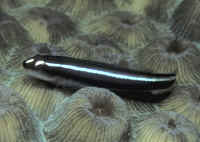
|
| Gobiosoma oceanops (Jordan
1904), THE Neon Goby. Tropical West Atlantic; southern Florida to
Belize. To two inches in length. |
 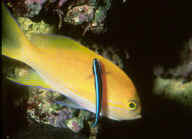
|
| Gobiosoma prochilos Bohlke & Robyns
1968, the Broadstripe Goby. Tropical central West Atlantic. To four
cm. Bred in captivity. These off of Cancun, Mexico. |
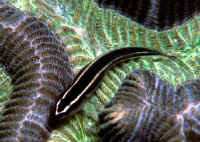 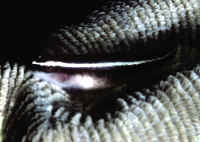
|
| Gobiosoma randalli Bohlke
& Robins 1968. Yellownose or Randall's Goby. Tropical West
Atlantic; Puerto Rico to Venezuela. To under two inches in length.
Here are an individual in captivity, and one off
Bonaire. |
 
|
Genus Coryphopterus:
| Coryphopterus dicrus Bohlke & Robins
1960, the Colon Goby. Tropical West Atlantic; Florida to Venezuela.
To two inches in length. In the Bahamas. |
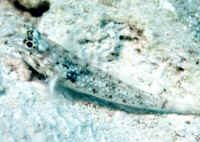
|
| Coryphopterus eidolon Bohlke & Robins
1960, the Pallid Goby. Western Atlantic; Florida to the Lower
Antilles. To two and a quarter inches in length. This one in the
Bahamas. |
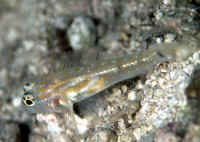
|
| Coryphopterus glaucofraenum Gill 1863, the
Bridled Goby. Western Atlantic; N. Carolina to Brazil. To three
inches in length. One photographed in the Bahamas, another
down south in Bonaire. |
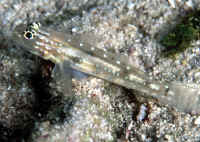
|
| Coryphopterus personatus, (Jordan &
Thompson 1905), the Masked Goby. To 4 cm. Western Atlantic; Florida
to Lower Antilles. Bonaire pix, where this species is ubiquitous on
the coral reefs. |
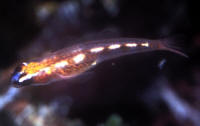
|
To: Part 1, Part
2, Part 3, Part
4, Part 5, Part
6, Part 7, Part
8, Part 10, Part
11,

